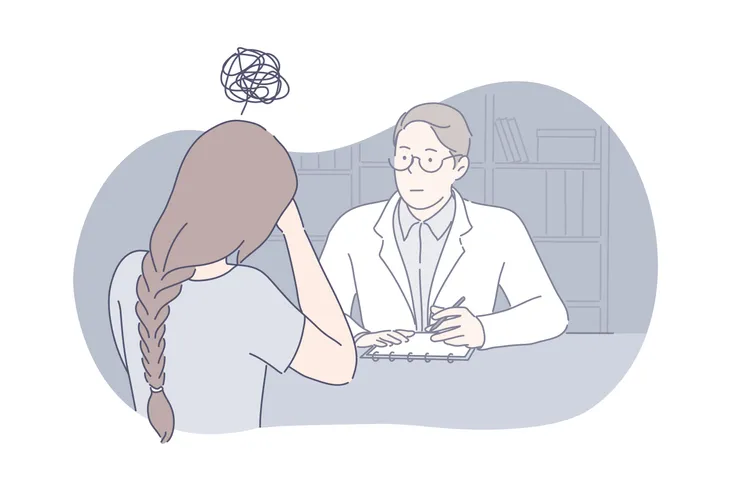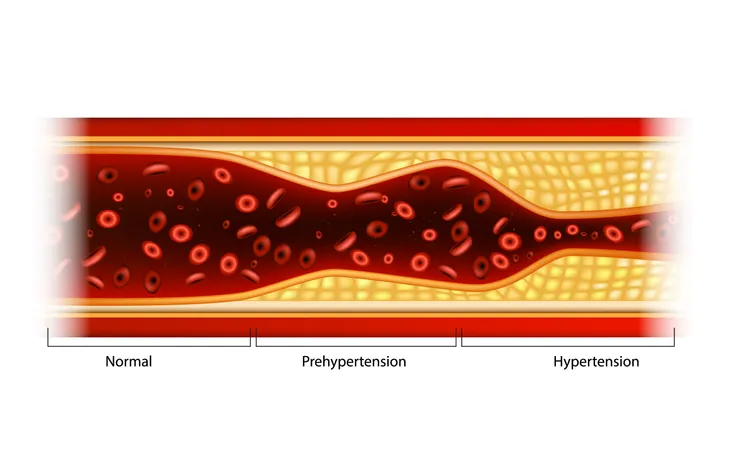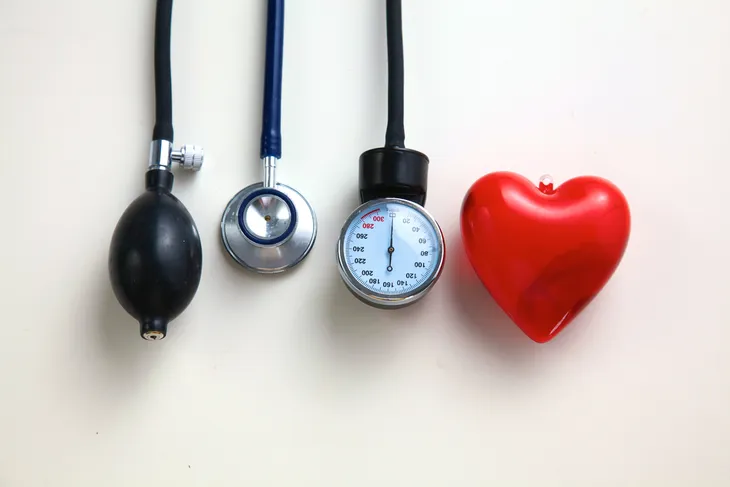- White coat syndrome is when a person’s blood pressure rises at the doctor’s office, particularly during a blood pressure reading.
- It’s often caused by anxiety and stress, past medical distress, trauma, or some experts believe it’s a precursor to actual hypertension.
- There is no set treatment plan for white coat syndrome. The best way to deal with it is to take multiple readings.
- To help overcome white coat syndrome, patients should arrive early, relocate to a quieter room, change the conversation, and practice relaxation techniques.
Most people don’t enjoy going to the doctor’s office. It’s kinda like going to the dentist. It’s not anybody’s idea of fun, but we all have to do it. While it’s mostly a hassle for most people, for others, going to the doctor can actually be anxiety-producing. They might feel nervous or anxious around healthcare professionals.
There’s actually a name for this — it’s known as white coat syndrome or white coat hypertension because the unforeseen anxiety cause a spike in their blood pressure. Here’s a look into everything to know about this condition, including how it’s diagnosed, the potential causes, treatment options, and some tips on how to overcome it. Let’s take a look…
What is White Coat Syndrome?
White coat syndrome, sometimes referred to as white coat hypertension, is when a person’s blood pressure is normal at home, but then rises slightly at the doctor. The name comes from the white coats that medical staff and doctors sometimes where in professional settings.
According to Healthline, a normal blood pressure reading is around 120/80 mm Hg. Anything above this is considered high blood pressure. “White coat syndrome may make your blood pressure read higher than it normally is, and the effect isn’t always a minor issue of doctor-associated anxiety,” writes the source. In some cases, experts worry it could be a sign of a more serious blood pressure condition.
White Coat Syndrome vs. Hypertension
These two conditions are similar, but quite different. White coat syndrome is essentially a phenomenon while hypertension is an actual condition that requires treatment. In the case of white coat syndrome, people only have high blood pressure when they are at the doctor’s office or in a medical setting. When they are at home or basically anywhere else, their blood pressure is normal.
According to Healthline, about 15 and 30-percent of people who experience white coat syndrome will actually have hypertension. However, experiencing a spike in blood pressure while at the doctor’s office doesn’t mean you have general hypertension. The same goes for the other way around. People with hypertension don’t always experience high blood pressure while at the doctor’s office.
Cause: Anxiety
The most obvious reason behind the cause is that some people feel stress and anxiety when they visit a healthcare center. While it’s not uncommon for people to feel a bit of anxiety when they visit the doctor, the anxiety can have an effect on blood pressure numbers.
The problem is that when someone feels anxious or stressed their body releases stress hormones like adrenaline and cortisol, explains PsychCentral. These hormones cause your heart rate to increase and blood vessels to narrow. The result is that blood pressure then rises higher than it likely is while you’re at home and relaxed.
Cause: Past Medical Distress or Trauma
Some people might be more likely to have white coat syndrome as a result of past experiences at medical offices. PsychCentral lists the following as possible traumatic experiences with a doctor: a procedure that causes (unexpected) pain, learning about a life threatening medical condition, experience with sudden medical issues, or witnessing a family member pass away in a hospital.
Another potential cause is past trauma. Trauma is a “natural, emotional response to events like natural disasters, accidents, or assault,” explains PsychCentral. People who go through a traumatic experience might suffer from long term reactions like intense emotions, flashbacks, strained relationships, and even experience physical symptoms like headaches or nausea. These symptoms might resurface during high-stress situations like being at the doctor’s office.
Cause: Hypertension
The last potential cause is that the patient could actually have hypertension. Some experts believe that white coat syndrome is a precursor to hypertension. “Stress and anxiety may play a role in high blood pressure, so people with white coat hypertension may still be more at risk of blood pressure-related issues,” writes Medical News Today.
The same source refers to a 2015 study published in the Journal of the American College of Cardiology which found that people with white coat hypertension were also more likely to experience cardiovascular issues. The source notes that the risk appears to be small, especially in comparison to people who have sustained hypertension.
How is it Diagnosed?
Not surprisingly, it’s difficult to diagnose white coat syndrome. Medical professionals have to be able to decipher whether it is actual hypertension or the white coat effect. According to Medical News Today, if a blood pressure reading is high a doctor might recommend the patient come back in a couple weeks for another reading. The problem is, a person with white coat syndrome will likely have another high reading at their next appointment.
If this is the case, they might need to do the reading in another location where the patient is more comfortable. They could recommend using a home blood pressure monitor or ambulatory blood pressure monitor (ABPM), explains the source. If they use an ABPM, they’ll need to wear it for 24 hours. These devices measure blood pressure throughout the day while a person is at home, doing their everyday activities. A doctor can use these readings to compare what a person’s blood pressure is at home and whether or not they need treatment for hypertension.
Treatment
Unless a patient has hypertension, there’s not much a doctor can do to treat white coat syndrome. Medication to treat high blood pressure cannot be prescribed based off one reading, says Medical News Today. If a person is taking blood pressure medication unnecessarily, it could lead to hypotension, when a person’s blood pressure drops too low. In this case, they will likely experience dizziness and fainting, especially when standing up.
The easiest thing to do is to re-take the reading. In most cases, the doctor or nurse will recommend the patient try to relax. Take a couple deep breaths and either stops talking to focus or starts talking as a distraction. These techniques can often help get a lower reading. If it turns out a person does have hypertension, treatment will include medication or lifestyle changes, notes the source.
Complications
While it’s by no means a life-threatening or even complex diagnosis, hypertension is still concerning because it causes strain and damage to the heart. Even if it’s only temporary. If this temporary increase occurs for a long period of time, Healthline warns that the damage can be severe.
Medical News Today also points out that some experts believe people with white coat syndrome have a risk of future hypertension, cardiovascular complications, and organ problems. Be careful with this though because the source also warns that an incorrect diagnosis of hypertension can affect a person’s insurance rating and lead to costly and unnecessary long-term treatment.
Tip: Relax
If you’re already aware that your blood pressure spikes when at the doctor’s office and you’re worried about it, it just adds fuel to the fire. The worry of a high blood pressure reading may cause enough anxiety to boost your blood pressure, says Healthline.
While it’s easier said than done, try to relax. If you’re feeling overwhelmed, as the doctor or nurse to wait a bit to give you time to calm down. Make sure your feet are flat on the ground, close your eyes, and take a couple deep breaths.
Tip: Change the Conversation
Sometimes a doctor or nurse will talk to you while they are doing something that might cause anxiety like giving a needle or taking your blood pressure. Talking can help distract a patient from their test and improve their blood pressure reading, says Healthline.
This works wonderfully for some people! For others, sitting quietly might be more relaxing. If you notice a higher reading when talking, try sitting quietly for the next one. And vice versa.
Tip: Arrive Early
This one might seem obvious, but if you’re anything like me, you’re always running late! To help keep your blood pressure from rising, give yourself lots of time to arrive to your appointment. Arrive early so there is time for relaxation techniques like deep breathing and guided imagery prior to seeing the doctor.
It also allocates extra time during your visit with the doctor to talk to them about white coat syndrome. They can provide tips on how to deal with it and likely have time to take the reading again at the end of the appointment when you’re feeling more relaxed. Hopefully, they’ll be able to get a lower measurement.
Tip: Relocate
Doctor’s offices and hospitals are often crowded with people. Certain areas, particularly in the hospital might be more anxiety-producing than others, such as triage or emergency room. If you’re someone who struggles with white coat syndrome, it might be a good idea to ask the doctor or nurse if you can relocate to a quieter area.
A simple relocation might help make you feel more comfortable and allow them to get a more accurate measurement.














